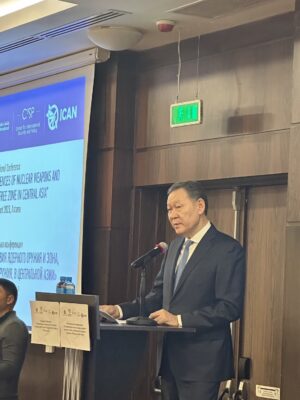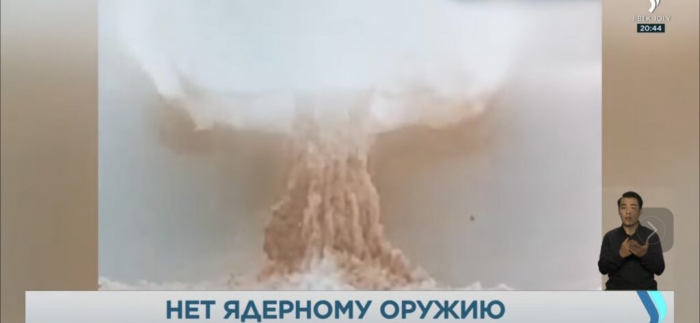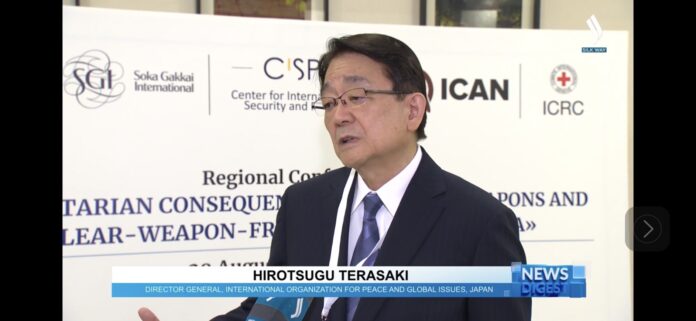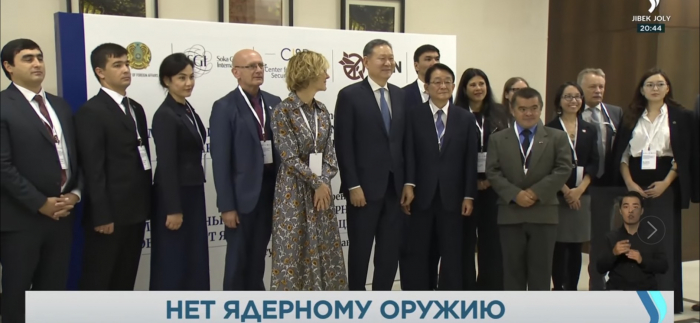A Group photo of participants of the regional conference on the humanitarian consequences of nuclear weapons and nuclear-free-zone in Central Asia held on August 29, 2023. Photo Credit: Jibek Joly TV Channel.
By Katsuhiro Asagiri and Kunsaya Kurmet-Rakhimova
Astana (INPS Japan/ Jibek Joly(SilkWay) TV Channel) —On this day 32 years ago (September 29, 1991), the Semipalatinsk Nuclear Test Site was permanently closed by a presidential decree in Kazakhstan, then a part of the Soviet Union, contrary to the position of the central government in Moscow. Kazakhstan subsequently gained independence from the Soviet Union and became the first country in the world to voluntarily turn itself to a non-nuclear weapons state from a nuclear weapons state by abolishing all of its nuclear arsenal, the fourth largest in the world at the time, and removing them to Russia.

The “Humanitarian Impact of Nuclear Weapons and the Central Asian Nuclear-Weapon-Free Zone” regional conference held in Astana on Aug 29, 2023. Photo credit: Katsuhiro Asagiri, Multimedia Director of INPS Japan.
Eighteen years later, in 2009, at the initiative of Kazakhstan, the UN General Assembly adopted a resolution designating August 29, the day the test site was closed, as the International Day Against Nuclear Tests. With the threat of nuclear weapons being used again becoming a reality, is it really possible to achieve a nuclear-free world? What should we know about the threat posed by the use and testing of nuclear weapons? Jibek Joly TV Channel and INPS Japan interviewed Mr. Karipbek Kuyukov and some participants of the “Humanitarian Impact of Nuclear Weapons and the Central Asian Nuclear-Weapon-Free Zone” regional conference convened by the Ministry of Foreign Affairs of Kazakhstan, in partnership with the Center for International Security and Policy (CISP), Soka Gakkai International (SGI), the International Committee of the Red Cross (ICRC), and the International Campaign to Abolish Nuclear Weapons (ICAN), in Astana, the capital of Kazakhstan, to mark this year’s International Day.

Kazakhstan’s First Deputy Minister of Foreign Affairs Kairat Umarov delivered a opening speech. Photo credit: Katsuhiro Asagiri, Multimedia Director of INPS Japan.
At the regional conference, in his opening remarks, Kazakhstan’s First Deputy Minister of Foreign Affairs Kairat Umarov underscored that upholding the norm against nuclear testing and prevention of consequences of nuclear testing remained an integral part of the collective efforts to achieve and maintain a world without nuclear weapons.
Opening remarks were also delivered by Mr. Alimzhan Akhmetov, Director of CISP, Ms. Biljana Milosevic, Head of ICRC Regional Delegation in Tashkent, and Mr. Hirotsugu Terasaki, SGI Director General of Peace and Global Issues.
In the morning session examining the “humanitarian impact” of the use of nuclear weapons, Dmitriy Vesselov, a third-generation victim of nuclear testings, made a powerful testimony about the enormous negative impact of nuclear testing on human health from generation to generation and the social situation in which many Hibakusha have yet to receive relief despite governernts efforts.
No to Nuclear Weapons
On August 29, 1949, four years after the U.S. military dropped atomic bombs on Hiroshima and Nagasaki, the first nuclear explosion test was conducted at the Semipalatinsk Nuclear Test Site (the size of Japan’s Shikoku Island or Belgium), which the Soviet government established in today’s northeast Kazakhstan. The test changed the lives of all Kazakhs, including the residents of Semipalatinsk (now Semey City). Over a period of subsequent 40 years, 456 nuclear tests, including 25 on the ground and 86 in the air, were conducted on land traditionally considered sacred by the Kazakh people, and it is estimated that more than 1.5 million Kazakhs were affected by the radioactive fallout that fell on the surrounding area on the wind.

Karipbek Kuyukov is an armless painter from Kazakhstan, and global anti–nuclear weapon testing & nonproliferation activist. Photo Credit: Jibek Joly TV Channel.
However, the nuclear tests have had a serious impact on the lives of the victims to this day. The famous Kazakh painter Kalipbek Kuyukov, who was born without hands after being exposed to radiation in his mother’s womb, is one of the victims of the many health problems caused at the genetic level by exposure to radiation in the vast area surrounding the nuclear test site. Kuyukov was an early participant in the Nevada-Semipalatinsk movement, which played a vital role behind the president decree for the closure of the test site, and has conveyed the horrors of nuclear testings through his artworks. He has painted portraits of survivors of nuclear tests, using his lips or his toes to paint them. “I paint them while thinking about those who died in the tests and praying that I can fulfill the mission I have set for myself,” said Kuyukov.

Dmitriy Vesselov, a third-generation victim of nuclear testing made a powerful testimony at the regional conference. Photo credit: Jibek Joly TV Channel.
Dmitriy Vesselov, who gave a testimony at the regional conference, is a third-generation survivor of the Nuclear testings in Semipalatinsk. His grandmother passed away from stomach cancer. He suffers from acromioclavicular dysostosis, characterized by the absence of the collarbone, and his hands are connected only by a few muscles and ligaments, making it impossible for him to do any serious work. He also has abnormal bone and skull development, making him susceptible to bronchopulmonary diseases and arthritis. “I have a non-fusion of the cervical vertebrae, which means that if I stay in an upright position for too long, the blood vessels supplying my brain and nerve endings begin to compress and I have to assume a horizontal position. I do not want my children to suffer from this disease. For this reason, I intentionally choose not to have children unless medicine takes a serious step forward and allows me to have healthy children.” said Vesselov.

Nuclear explosion at Semipalatinsk Nuclear Test Site. Photo credit: Jibek Joly TV Channel.
It is estimated that the nuclear weapons detonated at the Semipalatinsk Nuclear Test Site over a 40-year period were 2,500 times more powerful than the atomic bombs dropped on Hiroshima and Nagasaki. The importance of not repeating the historical tragedy inflicted by the use and testing of nuclear weapons due to nuclear confrontation, and the importance of providing support for today’s victims, were discussed at the regional conference.

Mr. Hirotsugu Terasaki, Director General of Peace and Global Issues of SGI which co-organized the regional conference with Kazakh Ministry of Foreign Affairs, CISP, ICAN and ICRC to commemorate the International Day against Nuclear Testing at Kazakh Capital on Aug 29.Photo credit: Katsuhiro Asagiri, Multimedia Director of INPS Japan.
Mr. Hirotsugu Terasaki, Director General of Peace and Global Issues of SGI, which co-hosted the regional conference, commented on the event that “I believe that this regional conference is a new milestone, a starting point for representatives from five countries of Central Asia (Kazakhstan, Uzbekistan, Turkmenistan, Kyrgyzstan and Tajikistan) to discuss how we can advance the process toward a nuclear-weapon-free world, given the ever-increasing threat of nuclear weapons.”
When asked about SGI’s cooperative relationship with the Ministry of Foreign Affairs of Kazakhstan, he replied, “SGI is an international organization headquartered in Japan with experience of the atomic bombings of Hiroshima and Nagasaki, but we have established contacts with Kazakhstan on nuclear disarmament issues at various international conferences, and over the years we have co-hosted side events at international conferences on NPT (Nuclear Nonproliferation Treaty) and TPNW (Treaty on Prohibition of Nuclear Weapons) .”
In response to a question about what kind of assistance Kazakhstan could provide to the victims of the nuclear tests as Japan has experienced in providing assistance to Atom-bombing survivors, he said, “I think that Japan’s experience in how the Japanese government and the international community cooperated after the atomic bombings of Hiroshima and Nagasaki may also be a useful reference standard for Kazakhstan. However, since a scientific basis is inevitably required for each decision, I think that Kazakhstan could take on the challenge of how it can proceed with a rational decision while proceeding with the process carefully, but also quickly providing benefits to those who are suffering now, while gaining the support of the public. I hope that Kazakhstan will take up the challenge in this direction.” said Mr. Terasaki.
Interview with Mr Hirotsugu Terasaki, Director General of the Soka Gakkai International (SGI). Filmed and edited by Katsuhiro Asagiri, Multimedia Director of INPS Japan.
He pointed out that the provisions of Articles 6 and 7 of the TPNW (requiring state parties to provide assistance to victims of nuclear uses and tests and environmental remediation to affected area, and international cooperation), which were discussed at the regional conference, are currently under discussion in the international community to advance these provisions, and that Kazakhstan has been appointed as the co-chair (along with Kiribati) of the working group that is at the center of these discussions. In that sense, we will do our utmost to support Kazakhstan in advancing its own challenges in a synergistic way, while drawing on its experience within the international community.” said Mr. Terasaki.
Mr. Vesselov pointed out that in Kazakhstan, the state provides special medical insurance and benefits to victims of nuclear tests, but only those who are certified as disabled or to one of the family members of a person who died from diseases caused by ionizing radiation. According to this category, he argued, many victims of nuclear testing who are not categorized as handicapped person like himself remain ineligible for assistance.
About the future, Mr. Veselov said, “My last name ‘Vesselov’ means ‘Joyful’. Even with these problems, life goes on, so I will continue to look forward without despair. I hope that my testimony will serve as an example of the dangers of nuclear weapons and as a wake-up call to those who talk about the use of small tactical nuclear weapons and a limited nuclear war. It is the wish of the victims of nuclear weapons that this terrible scourge will never be repeated anywhere on earth.” said Vesselov.

The 2nd meeting of state parties to TPNW will take place at the United Nations Headquarters in New York between 27 November and 1 December this year.
Last year, President Kassym-Jomart Tokayev stated that “nuclear explosions have caused severe damage to the Kazakh land. Such a tragedy should not happen again. Our country will stand firm behind the principles of nuclear security.” At the regional conference, participants noted Kazakhstan’s appointment as President-designate of the third Meeting of States Parties to the TPNW. Member States of the Treaty of Semipalatinsk were encouraged to support Kazakhstan in this endeavour, and in its efforts to represent the Central Asian region’s contribution to nuclear disarmament, through attending the second Meeting of States Parties of the TPNW, at least as observers, which will take place at the United Nations Headquarters in New York between 27 November and 1 December this year, and by signing and ratifying the TPNW at the earliest opportunity. [INPS Japan/ Jibek Joly TV Channel — September 9, 2023]
Original Article: https://inpsjapan.com/en/sdgs-2/kazakhstans-enduring-legacy-from-nuclear-test-site-to-leader-in-disarmament/
More about:
















































